Biology
A popular zombie TV show is called, "The Walking Dead." The George Romero films call zombies the ?living dead.? Can you say that corpse-like people have life? Let?s recall our two varieties of zombies we talked about last week, those that were dead, but have been reanimated (brought back to life), and those that haven?t died specifically, but exhibit zombie behaviors.
But T. dohrnii can revert from medusa to polyp and then start the process all over again. It?s hard to say that they are truly immortal, they can still get eaten or sick, and how would we know if they did live forever; have you ever done anything forever?? Wait - downloading a movie on a 2009 MacBook Pro takes forever.
Cell theory didn?t come about all at once. Different scientists added different parts, including Rudolph Virchow, the father of modern pathology (pathos = disease, and ology = study of). The TED video series has a good video about the weird history of the cell theory, including how Virchow?s contribution was probably stolen from someone else.
In multicellular organisms, both forms can occur. For instance, your muscles hypertrophy, while your prostate undergoes hyperplasia. Really, most instances of hyperplasia in humans is pathologic.
A new study has begun to study how your body weight is maintained whether you take in too many calories or too few. Your set point weight will be maintained until too much change has occurred over time and a new set point is established. This study found that many organs are involved, and are controlled by the brain in the effort to maintain a weight even when too much energy has been taken in. This neuronal pathway may be a new way to manipulate weight gain and loss.
In the infectious disease form of zombies, where the dead body is reanimated by the bacteria, virus, or parasite growing within them, they make more zombies by biting someone and passing on the infection. And they bite two friends, and they bite two friends, and so on?. The population grows geometrically.
TedEd video (2013). The Wacky History of the Cell Theory TED
Campos M, & Jacobs-Wagner C (2013). Cellular organization of the transfer of genetic information. Current opinion in microbiology, 16 (2), 171-6 PMID: 23395479
Yamada T, Tsukita S, & Katagiri H (2013). Identification of a novel interorgan mechanism favoring energy storage in overnutrition. Adipocyte, 2 (4), 281-4 PMID: 24052907
For more information or classroom activities, see:
- Prokaryotes Vs Eukaryotes
While eukaryotic cells and prokaryotic cells have some characteristics in common, they diverged from their common ancestor billions of years ago, thus accounting for significant differences in overall structure and function. Here we will go over them....
- Mitosis Vs ...
Mitosis can be compared to a couple of different cell actions. But what makes it different?Mitosis is the process of which a cell divides and creates copies of itself, the main purpose of this being to help the organism grow or to replace cells that are...
- What Is Biology?
What is Biology? the science of life or living matter in all its forms and phenomena, especially with reference to origin, growth, reproduction, structure, and behavior. http://dictionary.reference.com/browse/biology Biology is a natural science which...
- Prokaryotes Versus Eukaryotes
Cell Webquest ? Ms. Carter Prokaryotes versus Eukaryotes California Standard: Cell Biology 1. c Cell Biology: The fundamental life processes of plants and animals depend on a variety of chemical reactions that occur in specialized areas of the organism?s...
- Unifying Themes In Biology
this will be built on heavily as posting progresses. These unifying ideas should help to make it so that the interconnectivity of biology is clearer, so while learning, questions like "what is this all for/why is it important?" can be answered. 1. Emergent...
Biology
The Living Dead - Living Or Dead?
Biology concepts ? characteristics of life, cell theory, reproduction, homeostasis, evolution
 |
| How could this monster have come from the Walking Dead TV show? In what way is he/she walking, and while she is in dire need of a makeover, can you consider her dead? |
In either case, they are moving and eating and moaning, and generally disrupting the social order. So are they forms of life? To answer the question, we first have to ask what it takes to be considered alive. What characteristics of living things separate them from non-living things?
Don?t laugh, it?s not always so easy to tell if something is alive or not. There have been several different systems for defining life, everything from mechanism, which says life is just a special set of chemical reactions, to vitalism, which says life consists of a vital force all its own and doesn?t obey the laws of physics.
Philosophers and scientists in history have searched for a single attribute definition of life ? the one thing that separates all life from all non-life, but it hasn?t been very successful. How about, ?livings things die?? Although it sounds sexy at first, this isn?t a very helpful definition.
Death is just an absence of life, so wouldn?t you need to define life first? Anyway - living things can die, but that doesn?t mean they must die. There is a species of jellyfish, Turritopsis dohrnii, which very well may be immortal. Most jellyfish start out as an immature polyp which develops into a medusa (the bell shape with all the trailing filaments). Then they get old and die.
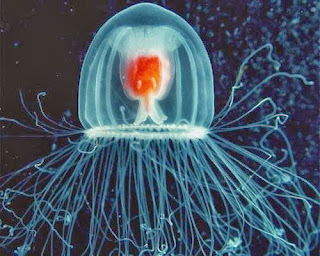 |
| This is the medusa form of T. dohrnii. The many hairs have nematocysts to capture prey, while the red area contains what nervous tissue the animal has, as well as the digestive system. At any point in its life cycle, it can regress to its infant form (polyp) and then send out clones of itself and grow up again. It would be is if you and your parents were the same age! |
Think about the number of exceptions to biologic rules we have discovered together in the past couple of years. Do you really think there can be one attribute of living things to which there is no exception, counter-example, or borderline case?
Some scientists say that we can't define what constitutes life because, as of now, we are limited to knowing only life on Earth. Life elsewhere may be completely different. But according to this line of thinking, you could never define life, because you couldn?t ever know if you had found every candidate in the universe.
For now, a list of characteristics that living things all possess and non-living things do not is most appropriate. Some folks use four characteristics, some five, six, seven or eight. I tend to go with a seven characteristic set, because that?s the number of items that most people are able to remember. You think it?s a coincidence that telephone numbers are seven digits?
Let?s take a look at the seven characteristics and see how many are fulfilled by zombies.
Cells ? Living things are made of cell(s). This has been well discussed for hundreds of years and we haven?t found any exceptions to this rule. In fact, scientists have extended the idea of cells even further. Called the cell theory, the idea is that life is made of cells, the cell is the basic unit of life, and all cells come from other cells. Anyone disagree?
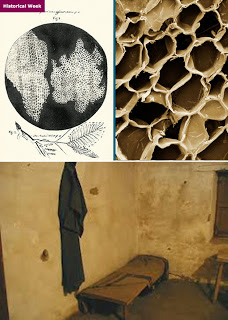 |
| The top left image is of a piece of cork as Robert Hooke would have seen it in his microscope. The right top image is a higher power microscope image of cork. Hooke thought the empty spaces looked like the empty rooms of monks (below), so he called them cells. In cork, you are really seeing the remnants of cells, only the cell walls are left. |
Organization ? Livings things are organized at one or many levels. Even a single-celled organism has organization. It has a membrane to keep it?s insides inside, and everything else outside. This is organization. A bacterium has a single (usually), large circular DNA on which is has coded all its genes. That?s organization.
Multicellular organisms inherently have more organization, since they have cells that must communicate with one another and start to have specialization of function, but all cells must transfer their hereditary material, and this requires great organization.
A new review has started to collate the evidence that this complex organization extends to the nucleus-less bacteria. It seems that bacterial RNA functions are sequestered in specific parts of the cell. These spatial relations seem also to affect the functions of the cell, so even at the lowest level of biologic organization, there seems to be a lot going on.
Biologic organization moves from small to big - cells, tissues, organs, organ systems, organisms. Bacteria jump straight from cell to organism, but we can go further. We can start with individuals and then move to populations, communities, ecosystems, and biomes. Even single celled organisms participate in these levels of organization. How about zombies?
Growth and development ? Living organisms increase in size and mass over their life cycle. This may be subtle, like budding yeast producing small offspring that then grow to become the same size as their parent.
Growth can take the form of hypertrophy, where existing cell(s) become bigger, or hyperplasia, where existing cells divide to become more cells. I leave it to you to decide which one occurs in single-celled organisms.
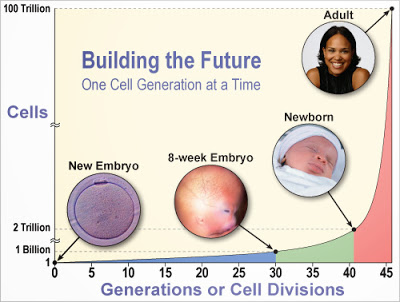 |
| Growth and development includes the increase in cell number as an organism grows. But cell division isn?t uncontrolled. You go from 1 cell to about 75 trillion, but there is also a lot of cell death. In the fetal state, if division was not accompanied by a whole lot of apoptosis (programmed cell death), a human newborn would weigh over a ton! |
That doesn?t mean that increasing cell number is always bad in humans. It?s how we develop from kids to adults, how we go from a single celled zygote to an infant. Do child zombies grow up to become adult zombies? I haven?t seen enough zombie movies to render an intelligent opinion.
Energy ? Living organisms acquire, store, transduce (change from one form to another) and expend energy. Acquiringenergy comes in three primary forms ? you gather energy from the sun (photosynthesis), from chemicals (chemosynthesis), or from eating other living things (hetertrophy). Zombies crave the flesh of other humans, so they are heterotrophs, cannibals to be specific.
Usingenergy means doing work ? living things do work. Cells build and breakdown molecules (metabolism) and use those molecules to do work ? produce heat, move, grow, sense and respond. Zombies move, although not very quickly. How slow must you be to end up a zombie meal?
Response ? Living organisms have systems in place to maintain optimal growing conditions for themselves, even as the conditions around them change. In scientific terms, we call this homeostasis(homeo = similar to, and stasis = stand still).
Remember in National Treasure when Jon Voight said, ?maintain the status quo.? That?s homeostasis in a nutshell. However, the processes to accomplish this can be quite complex. Just think about how many things must happen for you to try and stay cool in the heat or stay warm in the cold. Shivering alone is a very complex process of mini-spasms in your muscles.
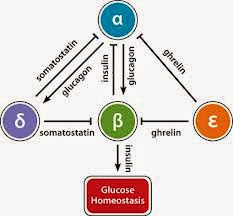 |
| Maintaining your blood glucose is one form of homeostasis. Using energy lowers blood glucose, eating raises it, but you need it to be steady. Hormones like glucagon raise the levels of glucose in the blood, while insulin lowers it. Grehlin and somataostatin work on your hunger and all these work through several different cell types in your digestive tract; alpha, beta, delta, and epsilon cells are all involved. |
Reproduction ? Reproduction could mean a couple of different things. It could refer to the replication of DNA in each cell, with the passing on of hereditary material to each of the daughter cells.
In some organisms, replication and reproduction (budding or binary fission) occur together. This is most often asexual reproduction, but yeast are single-celled organisms that can exchange some DNA in a sexual mode and then divide to produce two offspring.
Do you think zombie cells replicate and form two daughter cells? If so they do a lousy job of it. Zombies looked so decayed and lose so much tissue that I find it hard to believe that they are replacing lost cells by mitosis. How about reproduction as defined by producing more versions of the parent?
For many organisms, sexual reproduction is how they produce more individuals of their species. Sexual reproduction requires replication by mitosis in all cells of the organism, as well as meiosis to produce gamete cells (sperms and ovum). I don?t know if zombies undergo sexual reproduction ? and I?m not going to ask.
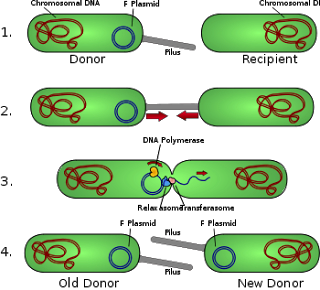 |
| Zombie production is more like bacterial conjugation than like reproduction. One bacterium possesses a characteristic coded for by DNA. It joins with another bacterium and transfers a copy of the different characteristic. Now both bacterium possess that trait. Sounds like one zombie biting a person and creating another zombie from them, doesn?t it. |
This is definitely production, but does it qualify under the definition of biologic reproduction? Aren't you more changing an existing organism than producing a new one? I think this is more about conjugation rather than reproduction (see picture).
Adaptation ? This means evolution. Nothing stays the same in nature. Even organisms that have been around for millions of years, like crocodiles and cockroaches, are always changing. Changing environments, fluctuating numbers of predators, etc. are constantly putting pressure on organisms. Mutations occur with or without changes around the organism, but pressures make some of the mutations positive changes and some negative changes. Those mutations that lead to more offspring and more surviving offspring are kept ? natural selection, and over time there are many of these adaptations ? evolution.
Remember, individuals do not evolve, only populations. So you couldn?t see a zombie evolve, even if you chose to stick around to watch ? bad idea. But do zombies as a species evolve?
So how do zombies stack according to our seven characteristics? Are they an exception or a borderline case? How about other things ? viruses, for instance. This is a common example for arguing about what life is. How about flame? That?s an interesting discussion to have.
Next week, some aspects of zombies involve free will - do you think they want to eat brains? Are there other examples in nature where something can steal your free will?
Next week, some aspects of zombies involve free will - do you think they want to eat brains? Are there other examples in nature where something can steal your free will?
TedEd video (2013). The Wacky History of the Cell Theory TED
For more information or classroom activities, see:
Immortal jellyfish ?
http://io9.com/5964375/could-this-immortal-jellyfish-unlock-the-secret-to-human-life-extension
http://news.nationalgeographic.com/news/2009/01/090130-immortal-jellyfish-swarm.html
http://deepseanews.com/2013/07/are-jellyfish-immortal/
http://www.mnn.com/earth-matters/wilderness-resources/photos/10-animals-with-the-longest-life-spans/turritopsis
http://www.scienceandthesea.org/index.php?option=com_content&task=view&id=487&Itemid=10
Characteristics of life ?
http://www.exploratorium.edu/imaging-station/activities/classroom/characteristics/ca_characteristics.php
http://www.stemmom.org/2012/06/living-non-living-vs-dead-lab.html
http://www.sciencelearn.org.nz/Science-Stories/Earthworms/Characteristics-of-living-things
http://infohost.nmt.edu/~klathrop/7characterisitcs_of_life.htm
http://www.google.com/url?sa=t&rct=j&q=&esrc=s&source=web&cd=9&ved=0CE0QFjAI&url=http%3A%2F%2Flibrary.thinkquest.org%2FC003763%2Fpdf%2Forigin06.pdf&ei=RkJIUv2hOsWFyQG71ICQDw&usg=AFQjCNEl09pxrocAprw9V7kj454ayYUm9A&sig2=z2VOEuuzkl4urIxt9XH9BQ&bvm=bv.53217764,d.aWc
http://www.sophia.org/tutorials/7-characteristics-of-life--2
http://www.cteonline.org/portal/default/Curriculum/Viewer/Curriculum?action=2&view=viewer&cmobjid=177519
http://www.essortment.com/six-characteristics-life-47733.html
http://www.pdesas.org/module/content/resources/13992/view.ashx
http://www.slideshare.net/jhaver/characteristics-of-living-things-2649122
http://www.seplessons.org/node/771
http://www.classroomfreebies.com/2012/01/characteristics-of-life-powerpoint.html
http://hwp.ocps.net/tl/knoxs/Links/5MainCharacteristicsofLife.htm
http://biology--dev.about.com/od/apforstudents/a/aa082105a.htm
- Prokaryotes Vs Eukaryotes
While eukaryotic cells and prokaryotic cells have some characteristics in common, they diverged from their common ancestor billions of years ago, thus accounting for significant differences in overall structure and function. Here we will go over them....
- Mitosis Vs ...
Mitosis can be compared to a couple of different cell actions. But what makes it different?Mitosis is the process of which a cell divides and creates copies of itself, the main purpose of this being to help the organism grow or to replace cells that are...
- What Is Biology?
What is Biology? the science of life or living matter in all its forms and phenomena, especially with reference to origin, growth, reproduction, structure, and behavior. http://dictionary.reference.com/browse/biology Biology is a natural science which...
- Prokaryotes Versus Eukaryotes
Cell Webquest ? Ms. Carter Prokaryotes versus Eukaryotes California Standard: Cell Biology 1. c Cell Biology: The fundamental life processes of plants and animals depend on a variety of chemical reactions that occur in specialized areas of the organism?s...
- Unifying Themes In Biology
this will be built on heavily as posting progresses. These unifying ideas should help to make it so that the interconnectivity of biology is clearer, so while learning, questions like "what is this all for/why is it important?" can be answered. 1. Emergent...
